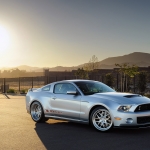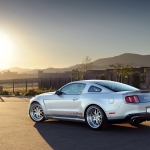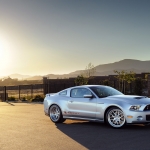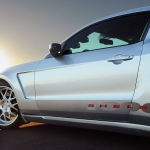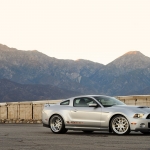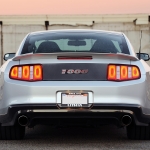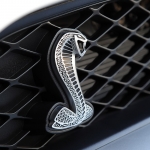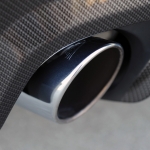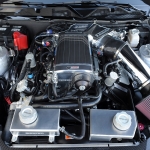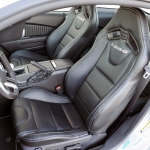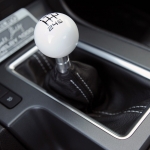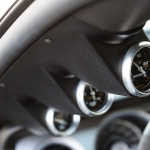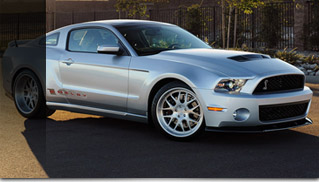 Shelby has been working their legendary magic on the GT500 since its modern reintroduction, first offering a 650 horsepower Super Snake package in 2007 and ramping up the performance nearly every year since. In 2011 Shelby offered up their most powerful Super Snake yet with an incredible 800 horsepower from the supercharged 5.4-liter V8. For most, that would be plenty of horsepower for a street car. For Carroll? Not quite enough.
Shelby has been working their legendary magic on the GT500 since its modern reintroduction, first offering a 650 horsepower Super Snake package in 2007 and ramping up the performance nearly every year since. In 2011 Shelby offered up their most powerful Super Snake yet with an incredible 800 horsepower from the supercharged 5.4-liter V8. For most, that would be plenty of horsepower for a street car. For Carroll? Not quite enough.
“Upon the completion of the 800 horsepower Super Snake we took him around the track in it and he was excited and he jumped out of the car and we all stood there expecting to get a big ol’ Shelby hug,” Shelby president John Luft tells us. Instead, they got a question they didn’t expect. “He looked at the development team and said ‘ok, when are we going to have 1,000?’”
It was then that the Shelby team began working diligently on what would simply be called the ’1000.’ Of course, Carroll was deeply involved in the project despite his age and declining health. “His involvement in the Shelby 1000 was from the day we put a pencil to paper to the day we took it around the track,” Luft remembers. “Carroll was actively involved in every aspect of the Shelby 1000′s development, from the design to the testing and ultimately his final approval.”
The concept was not just to build a Mustang with 1,000 horsepower, but to build the best Shelby Mustang from top to bottom. “It was conceived as the ultimate Shelby and honed during substantial testing.” says Gary Patterson, vice president of operations.
At the heart of the Shelby 1000 is a supercharged 5.4-liter V8, although it barely resembles the engine that is found in the stock GT500. While the Super Snake’s underhood upgrades mostly consist of a larger supercharger and an upgraded fuel and cooling system, Shelby left almost nothing untouched when it came to the 1000.
“We took the serious hot rod approach by taking Ford’s 5.4 liter engine down to the block, and beefed up the internals by machining it for new rods, crank and pistons,” says Gil Navarrez, Shelby American’s Speed Shop director. Shelby also added their own spec of camshafts, valve springs, titanium retainers, stage 3 ported heads, a high-flow fuel system with 80 lb injectors and an upgraded cooling package with heat exchanger.
Customers have a choice of a Kenne Bell 3.6-liter supercharger or a Whipple 4.0-liter supercharger. The Kenne Bell, used on this car, is matched to a single blade 2350cfm throttle body fed by a 4.5-ich inlet pipe and 127mm MAF. Both street and off-road track versions of the engine are available, producing either 950 horsepower on 91 octane or 1,100 horsepower on race fuel. The latter also includes a set of custom 2-inch racing headers with 3.5-inch collectors. Only a handful of other supercars can claim those numbers, and none come even close to the 1000′s price range.
Quite a lot was done to ensure the rest of the drivetrain remained intact as well. Horsepower is fed through a heavy duty twin-disc clutch and aluminum flywheel assembly, a custom aluminum driveshaft with billet flange and a custom 9-inch rear end with Wavetrac differential. A driveshaft tunnel brace and a billet transmission support were also added.
While Shelby’s main goal for the engine was to produce as much power as possible, they also didn’t forget to pay attention to the details. Items like the supercharger pulley and manifold have been etched with the Shelby 1000 name, and billet aluminum pieces can be found throughout the engine bay. A plaque on the valve covers also shows the specific CSM number for each 1000.
The 1000′s performance isn’t just limited to the engine, though. “This car is the total package,” Luft tells us. The basis for the 1000′s suspension is Eibach’s R2 adjustable suspension system, allowing the driver to change the ride settings for different scenarios. Shelby didn’t stop there, and has a full range of parts that come standard on the car including caster/camber plates, a lightweight k-member with tubular control arms, a billet aluminum watts-linkage and an anti-wheel hop upgrade.
The 1000′s brakes have been upgraded as well, courtesy of Wilwood. Up front are a set of 14-inch discs with 6-pistons calipers, while 14-inch discs with 4-piston calipers are at the rear.
While you might expect a 1,000 horsepower Shelby Mustang to have matching looks, the 1000′s appearance is actually somewhat tame. Luft tells us this is because of customer input during the design phase. “They overwhelmingly asked for this stealth exterior approach,” he tell us. “Something cast in the mold of the most serious muscle cars of the ’60s. Everything was engineered and designed with a ‘form follows function’ philosophy.”
Up front the 1000 gets a carbon fiber splitter, and a custom fiberglass hood provides a little more room for the larger supercharger system. The bulging hood is close enough to stock that it takes a keen eye to notice the difference. Out back is a new rear diffuser, and relatively subtle ’1000′ graphics are placed on the side and rear decklid.
Of course, for those customers that want something a little more aggressive Shelby also offers a widebody package. The new fiberglass fenders add six inches of total width to the car, allowing for 13-inch wide rear wheels and 10-inch wide front wheels. This particular car is the very first 1000 to get the widebody package.
Like the exterior, the Shelby 1000′s interior is relatively simple with only subtle styling changes. The GT500′s Recaro seats have been revamped by Katzkin and featured an embroidered Shelby 1000 logo. A new MGW short-throw shifter replaces the stock unit, just behind which lies a plaque with the car’s CSM number. Finally, Shelby adds an a-pillar gauge pod with readouts for boost, fuel pressure and oil pressure.
As you might expect, all of this comes at a price. The post-title package for the Shelby1000 starts at $149,995. Add in the cost of the donor Shelby GT500, and that puts you at $199,604 for a 2012 model or $204,199 for a 2013-2014 version. Want the track-only S/C version? Tack on another $5,000.
Yes, the Shelby 1000 is ludicrously expensive, and yes, you could probably build a similar car for cheaper. However, we still applaud Shelby for building the car. Just because we can’t afford one doesn’t mean we can’t appreciate what it is.
We imagine that the Shelby 1000 will be one of the most collectable Mustangs in years to come. Not only because it’s the most powerful or because it will be one of the rarest (production is limited to 100), but because it was the last car that Carroll ever saw to production.
